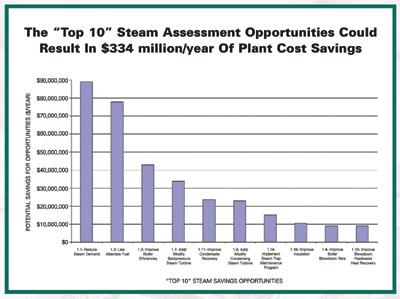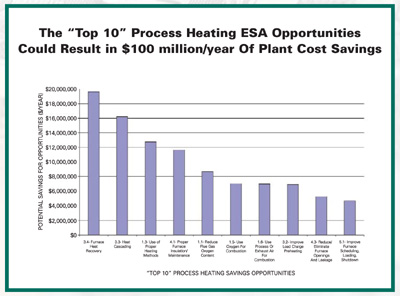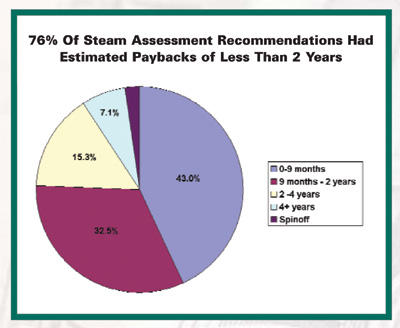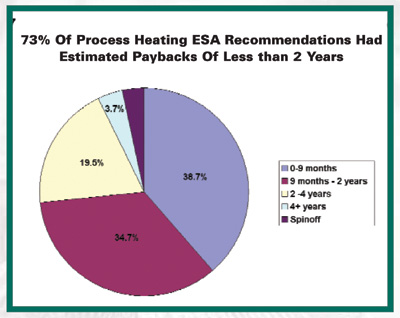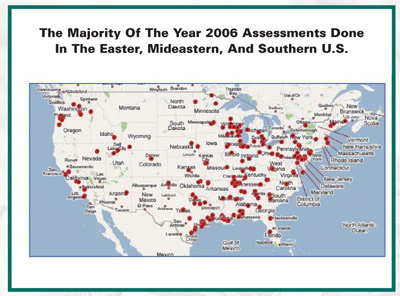Significant Save Energy Now Results Are In For 2006
Through the Save Energy Now (SEN) initiative, the Department of Energy’s (DOE’s) Industrial Technologies Program (ITP) helps industrial plants save both energy and money by conducting energy assessments using DOE software tools and technical information to determine how to reduce energy use in key industrial processes.
The energy assessments conducted by the DOE’s energy experts help manufacturing facilities of all sizes and in locations across the United States identify immediate opportunities to save energy and increase profitability. These assessments focus primarily on energy-intensive systems, including process heating, steam, pumps, fans, and compressed air. Insulation systems have proven to be one of the top 10 steam and process heating assessment opportunities that can result in huge dollar savings per year for participating facilities (see Figures 1 and 2). Plus, 76 percent of steam assessment and 73 percent of process heating assessment recommendations had estimated paybacks of less than 2 years (see Figures 3 and 4).
Here are some key results from the 2006 SEN assessments:
- Identified natural gas savings: 53 trillion British thermal units (Btus) per year
- Natural gas savings per year: Equivalent to the annual natural gas consumed by 725,000 typical homes
- Identified cost savings potential: $500 million per year
- Total potential carbon dioxide (CO2) emissions reduction: 4 million tons per year
The majority of the 2006 assessments were performed in the Eastern and Southern United States. (See Figure 5 for a detailed map.) SEN assessments were completed in 18 major U.S. industry sectors, with 163 of the assessments in six industry sectors (see Figure 6).
In 2006, 114 steam assessments were done in 37 states. Total recommended steam savings for 2006 were $364 million per year. Analysis of steam systems included the following:
- Boiler and combustion systems
- Combustion analyzers
- Boiler blowdown
- Individual end-use equipment
- Turbines
- Condensate systems and deaerators
In 2006, 86 process heating assessments were done in 30 states. Total recommended process heating savings for 2006 were $136 million per year. Analysis of process heating systems included the following:
- Melting furnaces
- Metal and non-metal
- Aluminum or non-aluminum
- Glass or non-metal
- Metal heat-treating
- Drying ovens
- Thermal oxidizers
Results That Speak for Themselves
According to results from a follow-up effort to analyze the 2006 SEN assessment program, the initiative has been quite successful. The following information was obtained during follow-up interviews with 179 plants 6 months after the assessments were completed:
- Energy savings projects worth $30 million per year were immediately implemented.
- Energy savings projects worth $98 million per year are in the process of being implemented.
- Energy savings projects worth $179 million per year are either being planned or are under review.
Of the plants that participated in follow-up interviews, 90 percent said the energy savings assessments influenced the decision to implement energy efficiency projects. The 12-month follow-up reports, with 128 plants participating, provided an even more vivid picture of the 2006 SEN program. These results included the following:
- Total savings of $81 million per year were obtained from implemented energy-saving projects.
- An additional savings of $70 million per year were expected from energy-saving projects that are under way.
- Projects that are scheduled to occur are expected to result in an additional $180 million per year in energy savings.
Hands-on training and active participation are both key factors in the SEN program’s approach. For 2006, the following results show that this “training assessment” approach pays off for facilities participating in the Energy Savings Assessments:
- From 3-day assessments, the average recommended savings have been about 10 percent of plant energy use.
- The majority of identified savings opportunities have paybacks of less than 2 years.
- The 6- and 12-month follow-up implementation results have been encouraging.
- Large industries and states continue to be enthusiastic about the SEN program and its efforts to help facilities save both energy and money.
To view the full report from the 2006 SEN assessments, please go online and visit www.eere.energy.gov/industry/saveenergynow/partners/results.cfm.
For additional information about the SEN program, please visit www.eere.energy.gov/industry/saveenergynow.

